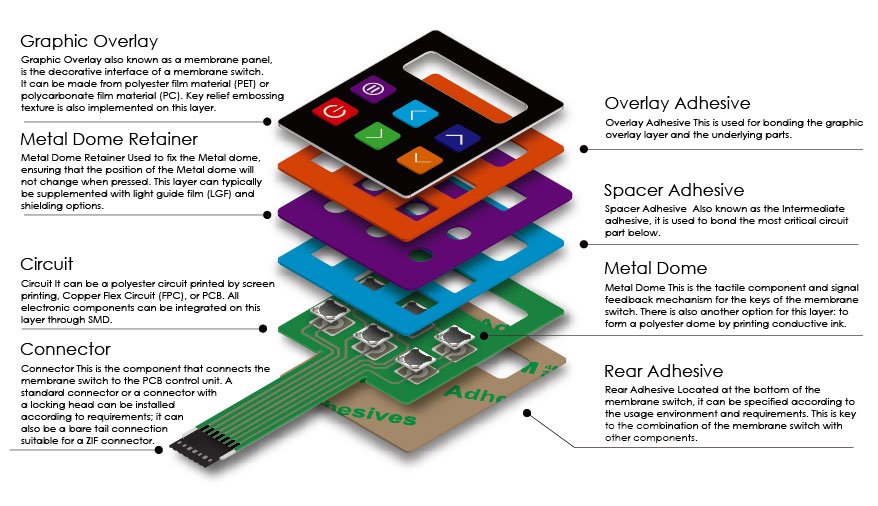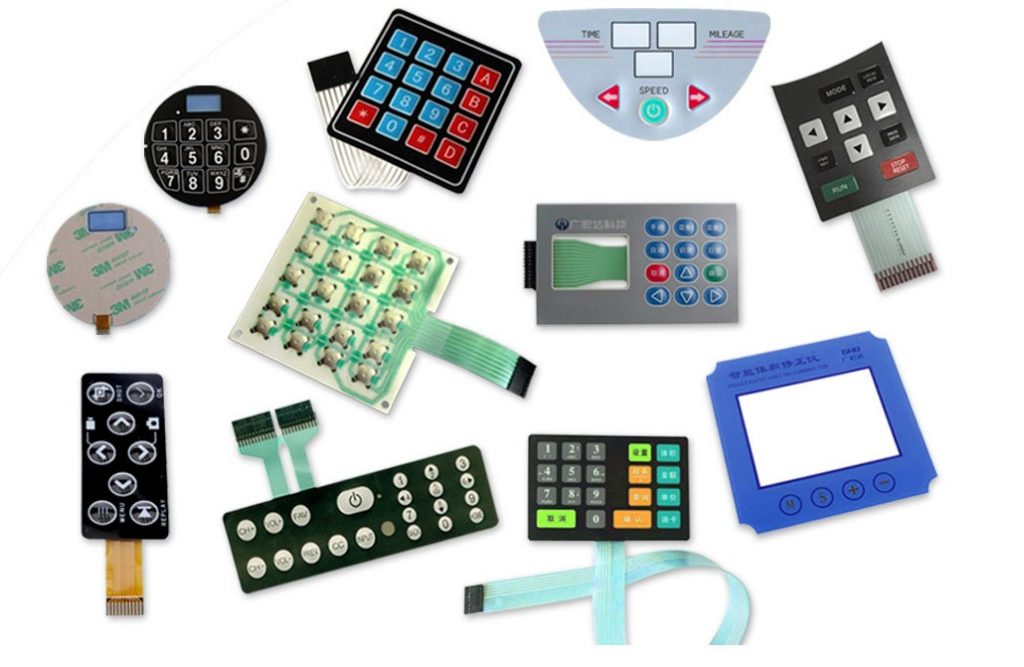All Concerning Membrane layer Change: A Comprehensive Guide for Beginners
Membrane buttons are vital components in modern electronics, offering a special interface for customer communication - membrane switch. Their layered building, consisting of overlays and conductive traces, supplies capability and resilience. Unlike standard mechanical switches, membrane buttons provide a smooth design and personalized alternatives. Understanding their key attributes and advantages can change item layout. The intricacies of their application and design considerations necessitate additional expedition.
What Is a Membrane layer Change?
A membrane layer button is a kind of electric button that includes an adaptable membrane layer layered over a published circuit board. This design enables a portable and sleek user interface, typically used in various digital tools. Membrane layer buttons are generally found in customer home appliances, medical equipment, and commercial equipment due to their sturdiness and resistance to environmental factors.The building normally includes multiple layers, such as graphic overlays and adhesive backing, which supply responsive comments and safeguard the circuitry below. The operation of a membrane button is initiated when stress is put on the surface, finishing an electric circuit.These buttons are valued for their convenience, making it possible for personalized designs and published graphics that deal with details interface. Their low-profile nature decreases area needs, making them perfect for applications where standard buttons may not fit. On the whole, membrane buttons supply a practical and visual solution for contemporary electronic gadgets.
Key Parts of Membrane Switches Over
Membrane switches over consist of a number of essential parts that contribute to their functionality and efficiency. The top layer, recognized as the overlay, offers the interface and is often published with icons or graphics. Beneath the overlay exists a spacer layer, which separates the conductive components and avoids unintentional activation. The following vital element is the visuals layer, which enhances visual appeals and assures the sturdiness of the design.Conductive traces, typically made from materials like silver or carbon, are published on the circuit layer. When pressure is related to the overlay, these traces enter into contact, finishing the circuit. Additionally, a backing layer supplies structural assistance and can be made from materials such as polyester or polycarbonate. With each other, these elements develop a reputable, user-friendly user interface appropriate for different applications, from family devices to industrial tools. Understanding these elements is necessary for anybody curious about membrane layer button modern technology.
Exactly How Membrane Layer Switches Over Job
Recognizing how membrane layer switches over feature is necessary for appreciating their extensive use in various devices. A membrane layer button runs with a series of layers, consisting of a visuals overlay, spacer, and a circuit layer. When stress is related to the overlay, it presses the spacer layer, enabling the circuit layer to make get in touch with and complete an electric circuit. This action sends out a signal to the tool, triggering a feedback, such as switching on a light or triggering a function.Membrane switches over can be created with different features, including responsive feedback, backlighting, and custom graphics, boosting individual communication. Their building and construction permits for a closed style, safeguarding the internal parts from dust, wetness, and pollutants. This toughness makes them appropriate for varied applications, from customer electronic devices to industrial devices. Overall, the simplicity and performance of membrane switches over add to their popularity in modern-day technology.
Benefits of Membrane Switches Mechanical Buttons
While mechanical switches have actually long been a staple in numerous gadgets, membrane switches over offer distinct benefits that make them increasingly appealing. One substantial advantage is their slim profile, permitting for more compact styles and better flexibility in item growth. Additionally, membrane layer changes attribute an uniform surface area, which improves aesthetic charm and streamlines cleansing, making them ideal for settings where hygiene is critical.Another benefit is their resistance to dirt and wetness. Unlike mechanical buttons, which can be compromised by environmental elements, membrane switches give a closed interface that secures versus contaminants - membrane switch. Moreover, membrane layer switches commonly have a longer life expectancy as a result of less moving components, leading to boosted longevity and reliability.Cost-effectiveness is additionally a remarkable benefit, as membrane layer switches can be produced in bulk with reduced manufacturing expenses. These variables integrate to place membrane layer buttons as a practical option to traditional mechanical choices in different applications
Common Applications of Membrane Switches Over
Membrane layer switches are widely made use of in various industries, specifically in customer electronics and commercial control board. In customer devices, they provide a smooth, straightforward interface, while in commercial settings, they boost longevity and functionality. Understanding these applications highlights the flexibility and usefulness of membrane switches in modern-day technology.
Consumer Electronics Gadgets
As consumer electronics remain to progress, membrane layer buttons have come to be a preferred selection for a variety of devices as a result of their flexibility and smooth style. These switches are typically found in mobile phones, tablets, and push-button controls, where area is restricted and appearances matter. Their low profile and personalized styles permit suppliers to develop easy to use interfaces that boost the total individual experience. Additionally, membrane layer switches are commonly utilized in home appliances such as microwaves and coffee makers, offering instinctive control alternatives while standing up to wetness and dirt. The resilience and reliability of membrane layer switches make them ideal for day-to-day consumer products, ensuring longevity and consistent efficiency. Generally, their combination in consumer electronic devices look at these guys shows a blend of capability and contemporary style.
Industrial Control Panels
The applications of membrane layer changes extend past consumer electronic devices, locating substantial usage in industrial control board. These switches are favored for their durability and resistance to severe settings, making them perfect for producing and process control setups. They offer a dependable user interface for operators to regulate machinery, display processes, and change setups. Membrane buttons can be customized to match particular operational demands, integrating features like backlighting and tactile responses, boosting individual experience. Their low-profile layout permits for combination right into different equipment, while their capability to withstand spills, dirt, and severe temperatures assurances long life. Overall, membrane layer buttons add to risk-free and reliable operation in industrial applications, showing their adaptability and effectiveness in requiring environments.
Factors To Consider for Designing Membrane Layer Switches Over
When developing membrane switches, picking the appropriate materials is important to guarantee sturdiness and functionality. In addition, comprehending layer setup techniques can considerably affect the switch's performance and customer experience. These factors to consider play an essential duty in producing efficient and reputable membrane layer button designs.
Product Option Value
Product choice plays a necessary role in the style and functionality of membrane layer buttons. The picked products straight impact the button's toughness, responsive action, and general aesthetic. Secret factors to consider include the substrate, which must provide structural integrity while enabling flexibility, and the visuals overlay, which needs to be resistant to use and environmental factors. Conductive products must assure reliable electric efficiency, while adhesives should offer strong bonding without compromising the button's operation. Additionally, compatibility with manufacturing procedures and end-user atmospheres is crucial; products should endure Home Page differing temperatures, humidity levels, and chemical direct exposure. Eventually, proper product option not just enhances the membrane layer switch's performance yet likewise contributes to its long life and user contentment, making it a crucial aspect of the style process.

Layer Configuration Methods

Often Asked Inquiries
How Much Time Do Membrane Layer Changes Typically Last?
Membrane buttons usually have a life expectancy of 1 to 5 million cycles, relying on usage and ecological problems. Variables such as style quality and operating frequency substantially influence their toughness and general efficiency long life.

Can Membrane Switches Be Custom-made for Details Styles?
Membrane layer buttons can certainly be customized to suit details styles, permitting for varied forms, colors, and capabilities. This adaptability allows suppliers to great site customize these switches to fulfill special aesthetic and operational requirements efficiently.
What Products Are Used in Membrane Change Construction?
Membrane buttons are commonly created using products such as polyester, polycarbonate, and adhesive layers. These products provide resilience, adaptability, and resistance to ecological factors, making certain the switches work effectively in numerous applications and conditions.
Are Membrane Changes Immune or waterproof to Wetness?
Membrane layer buttons can be designed to be moisture-resistant, utilizing specialized products and coatings. Their waterproof capabilities depend on construction top quality and details applications, making it important to assess requirements for perfect performance in various settings.
How Are Membrane Changes Fixed if Damaged?
Fixing broken membrane layer switches typically includes changing the affected layer or circuit. Specialists may likewise apply conductive adhesive or make use of specialized repair service sets, guaranteeing performance is recovered without full replacement of the whole switch setting up. Unlike conventional mechanical switches, membrane layer buttons provide a streamlined design and customizable alternatives. A membrane layer button is a kind of electric switch that consists of an adaptable membrane layer layered over a printed circuit board. The operation of a membrane layer button is started when stress is applied to the surface, finishing an electric circuit.These switches are valued for their convenience, enabling custom-made designs and printed graphics that provide to certain customer interfaces. While mechanical switches have long been a staple in several devices, membrane layer changes offer unique benefits that make them significantly appealing. Membrane layer buttons generally have a longer life expectancy due to less moving parts, resulting in enhanced sturdiness and reliability.Cost-effectiveness is additionally a remarkable benefit, as membrane layer switches can be generated in bulk with reduced manufacturing expenses.